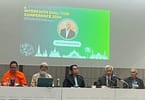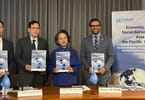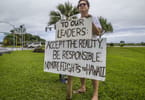本地视角
Madam Speaker, in February 2020 Jamaica recorded 6.0 percent growth in stopover arrivals and was on a trajectory to achieving double-digit growth in stopover arrivals for the year. However, the tourism sector, like many other sectors, was devastated by the global pandemic, which led to the closure of Jamaica’s borders to international travel on March 21, 2020.
This resulted in the shuttering of tourism establishments, including hotels, villas, attractions, shopping malls and ground transportation. For April and May, there was virtually no activity in the major components of the tourism sector. This led to a reduction in revenue for tourism operators and also those entities that supply the tourism industry, leading to widespread job losses.
The effects of the pandemic were also felt throughout the economy as tourism’s interconnectedness with other industries, including manufacturing, agriculture, entertainment, banking and utilities, has resulted in wide-scale financial fallout. Utility service providers, including the National Water Commission and the Jamaica Public Service Company, as well as a range of other players in the economy, to this day continue to feel the tremendous squeeze from tourism’s contraction.
Madam Speaker, the extent of the fallout in tourism is captured in the following figures:
· For the last fiscal year, the Jamaican Government lost direct revenue from the tourism sector of J$46.3 billion through airport charges and taxes, Guest Accommodation Room Tax (GART), General Consumption Tax, Tourism Enhancement Fund (TEF) collections, cruise taxes, and other government taxes.
· With the reopening of the borders on June 15, the total number of stopover arrivals up to March 2021 was approximately 464,348, as there were no cruise visitors during this period.
· With the anticipated number of arrivals of 2.8 million stopover visitors for the April 2020 to March 2021 period, the estimated retained visitor expenditure was $199.4 billion.
· However, with almost 500,000 visitors for the same period, the expenditure was only $44.7 billion and as such, the loss in visitor expenditure was $154.7 billion.
· Arrivals at the end of 2020, were 1.3 million of this 880,404 were from stopover arrivals and 449,271 from cruise. This represents a 68 percent decrease from the 4.3 million visitors to the island over the same period in 2019.
· Jamaica also recorded US$1.3 billion in earnings, which was a 62.6 percent decline in comparison to 2019.
Nevertheless, Madam Speaker, we remain hopeful and can report that the first three months of 2021 were positive. We welcomed 40,055 visitors in January, 40,076 in February and over 69,040 in March.
Madam Speaker, the general outlook for the upcoming fiscal year is quite positive as we expect to realize growth of 122 percent on earnings and 236 percent in visitor arrivals. Of this number, we hope to welcome 1.043 million stopover visitors, which is a 117 percent increase over last year’s stopover numbers.
Madam Speaker, our data indicate that Jamaica should have up to 60 percent coverage of the United States market by the end of May. We also anticipate that some 800,000 airline seats will become available for the upcoming summer, a number that is approximately 70 percent of the level experienced in 2019.
My colleague Minister, Hon. Nigel Clarke noted in his budget presentation that foreign exchange inflows from tourism are expected to fall by 74 percent for the 2020/21 fiscal year, which is a US$2.5 billion decline and will set back the country by 30 years.
The numbers tell the story. Tourism is a key driver of economies across the world, including that of Jamaica, through job creation, export revenues, infrastructure development and new business.
Therefore, it is up to us to reset the tourism industry, so that we can change this trajectory and place tourism on a path to recovery to fuel growth in the wider economy.
We must view this unprecedented crisis as a transformational opportunity. As we seek to rebuild our tourism economy despite COVID-19, we must embrace measures that will ensure a tourism product that is safe, innovative, attractive to visitors, and economically viable for all of our citizens.
OUR RESPONSE TO THE PANDEMIC
Madam Speaker, the pandemic has presented the greatest challenge to the sector that I have ever witnessed. All our previous gains, as well as strategies that had seemingly worked well up to a year ago, have laid a firm foundation on which we must now build forward stronger to meet the new demands of the post-COVID-19 tourism sector.
Madam Speaker, historically, tourism has shown a strong ability to adapt. As we seek to recover and prepare for the future, we embrace new strategies, a new orientation and new ethos that will ensure that the tourism sector becomes more resilient, sustainable, inclusive and competitive. I am confident that a strong multi-level response and partnership will help us to achieve full recovery.
Madam Speaker, our leading edge COVID-19 tourism recovery program has allowed for the seamless and safe reopening of our borders.
Just to give a brief recap, Madam Speaker, from as far back as March 2020, when the first wave of the coronavirus was reported in China, we announced measures to be adopted by all tourism entities to minimize the spread of the virus.
Our recovery process was guided by a five-point recovery strategy, which was managed by a multi-disciplinary task force:
- 健壮的健康和安全协议,可以经受本地和国际审查。
- Training all sectors to manage protocols and new behavioral patterns moving forward.
- Strategies around COVID-19 security infrastructure (Personal Protective Equipment (PPE), masks, infrared machines, etc.).
- 与本地和国际市场就重新开放进行沟通。
- 一种以结构化方式重新开放/管理风险的交错方法。
Specially assigned staff from the 旅游产品开发公司(TPDCo), who are a part of the Stakeholder Risk Management Unit, along with members of the COVID-19 Resilient Corridor management team, have been closely monitoring the implementation of these measures to ensure strict compliance.
Our protocols, which received the global endorsement of the WTTC, complement our highly successful Resilient Corridors to the north and south of the island, designed to keep workers, communities and visitors safe by only opening an area that we have the capacity to effectively monitor and manage.






















